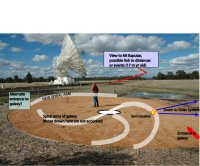Narrabri visitor centre redevelopment
Concept for Galaxy and Solar System Large Displays
v1 - 2 September2004
Link to majordomo discussion
This version describes possible ideas for the large galaxy and solar system displays as part of the redevelopment of the Australia Telescope Narrabri visitors centre.
Setting the Scene
These display are located adjacent to the north-east corner of the VC building and currently comprise two large flat areas next to each other. The proposal is that visitors proceed from the raised viewing platform in front of the north-east corner of the VC building around to a large display area with a visual representation of the Milky Way galaxy. This in turn would lead to an adjacent large area which would contain scale models of some of the planets in the Solar System. The photograph below is looking north to the areas allotted for the Solar System and galaxy displays.
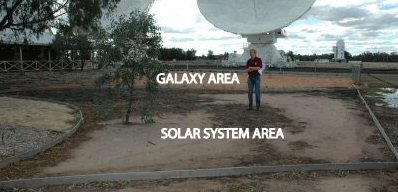
Ideas for Galaxy Display
The area allocated for the galaxy display is large and in a prominent location on the north-east corner of the VC. It has the potential to be a key feature of the outside displays and provides a link between the "telescope" sections and the "astronomy" sections of the display. The basic concept of a large representation of the spiral Milky Way galaxy suggests several possible options.
- One decision is whether the display seeks to be "realistic", "semi-realistic" or purely artistic in its representation of the galaxy. If either of the first two it could have some prominent features such as the nucleus, bar and s piral arms identified. It could also have the approximate location of the Sun marked. It may be worthwhile to try and incorporate the newly discovered arm if possible.
- The actual construction and style of the galaxy also needs to be selected although this will depend partly on the style of representation chosen. Possible ideas include:
- White or painted gravel compacted in. This is may be less stable in long term but is likely to be a cheaper option.
- Use larger rocks - more resistant but tempting for people to move.
- Mosaic tiles. This would be solid, durable and visually impressive but likely to be expensive.
- Larger paving tiles.
- Raised spiral arms such as 20 cm rounded mounds. This approach could utilise the idea of a labyrinth where visitors walk along path between the arms to the centre of the galaxy.
- Some form of painted galaxy although this would depend on the type of surface used in the area.
- A floral/vegetative galaxy where the spiral arms are planted in (eg white flowers) and the Sun is a yellow flower. Could be paved in between the arms.
- Other features that could be included are a link to Mt Kaputar visible in the distance. As this is 17 million years old we could include a graphic of a galaxy about 17 m ly distant and relate the two in time.
- The link to the adjacent Solar System display could use some form of "zoom" lines to indicate that it has a different scale.
The small picture below shows the scene visitors looking towards the galaxy. A larger version is available here. It has been annotated to show a basic layout of the galaxy (the spiral arms are not accurate thou gh!).
The map of the Milky way could be similar to that used in the May 2004 Sky and Telescope article on the new spiral arm. Its is shown below.
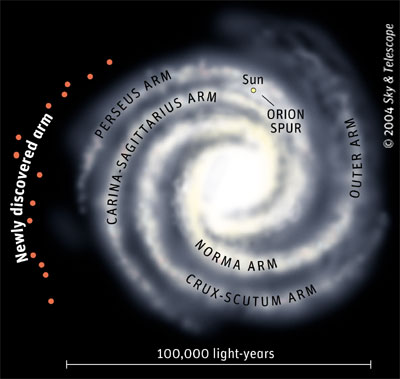
Ideas for the Solar System Display
The solar system display is adjacent to the galaxy display. To its south-east it looks across to the IPS domes and radio telescopes, providing a logical link for displays on the IPS and the Sun. The photograph below shows the Solar System display area looking north towards an antenna.
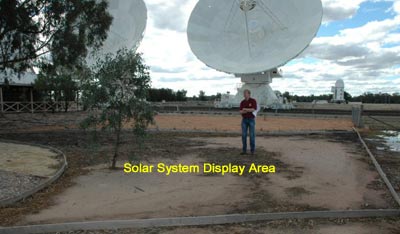
Some ideas for the solar system display include:
- As we are likely to have at least one antenna of the Compact Array close to the VC for at least 85% of the time it would be useful to use it to represent a scale solar disk. Using a 22 m dish as the size of the Sun the Earth becomes a 20 cm sphere. Scale painted models of some of the planets could be created and mounted on stands. Larger planets such as Jupiter ( a 2.2 m size) may have to be represented only partially or could be painted on the ground.
- The ground could have Sun and orbits of planets painted on our marked in compressed gravel.
- Continuing the scale analogy, info boards would describe the relative distances to the planets given a 22 m Sun. Earth would be about 2.6 km away with Pluto 94 km distant. We could have a regional map showing the scale orbits marked on. As scale is such an important part of most Science syllabi this section would make for useful activities for visiting school groups.
- Information panels on the different components of the Solar System would provide basic information.
- Examples of interactive displays would include a lift-up panel with a radio image of Jupiter with a "What is this?". When the panel is lifted an optical scale image of Jupiter would be visible. This would underpin the idea that observing at different wavebands may show different information.
- The south-east corner would be the logical place for information panels on the role and equipment at the IPS site.
- The section on the Sun then provides a logical link to the next section "Discovery Walk" which would contain more detailed sections on eg stellar evolution and the different types of stars.
The photograph below shows the Solar System display area looking south-east towards the IPS site.
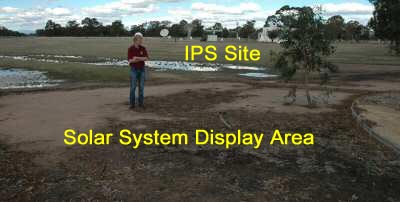
Original: Robert Hollow (3-September-2004)

